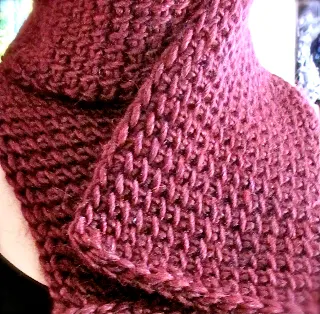 |
| "Burly" Men's Scarf in Tunisian Simple Stitch |
This left edge stitch has a front vertical bar, like the other Tunisian stitches of each row. It also has a few other vertical strands associated with that same stitch. In fact, it has a total of three vertical strands. Why? Because the last Tss of the row is always a chain stitch, and a chain stitch has three strands in it. (Watch how the last stitch is created next time you crochet it and then begin the Return Pass.)
Some crocheters insert the hook under just the one front vertical bar, same as for the rest of the stitches of the row; however, "endTss" means do not do that. Instead, insert the hook under the front vertical bar and one other nearest vertical strand of the stitch. The outermost one is the easiest.
Doing this, instead of picking up only one strand, will give the edge a more finished chained look. This two-strand chained effect is preferable because:
- It matches the other 3 edges better (especially if you began your project by working into the bottom third loop of the foundation chains).
- It has a bit more heft, so it helps stabilize and even out the edge more than a lone strand would (it is "self-finishing").
- If you will be crocheting a border along the edge, it's a better and more pleasant edge to work stitches into.
I'm not aware of it preventing curling though :-)
See the two-strand chained edge of this Burly Scarf?






























.jpg)










